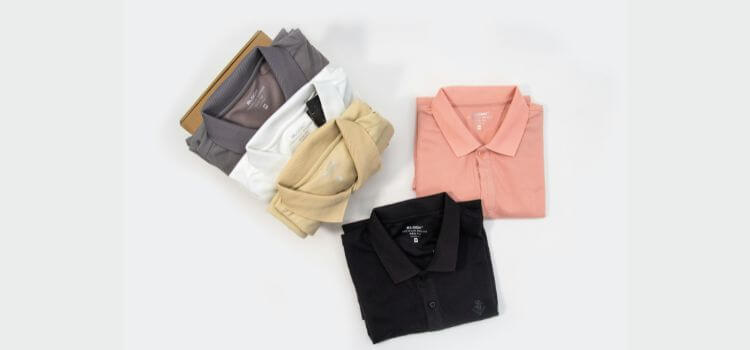As an Amazon Associate I earn from qualifying purchases.

A polo shirt is an iconic piece of clothing known for its versatility, style, and timeless appeal.
Whether you’re dressing up for a casual Friday at work, heading to a weekend outing, or even going for a smart casual dinner, a polo shirt can be the perfect choice.
But what exactly is a polo shirt, and why has it become such a classic wardrobe essential worldwide?
In this in-depth guide, we’ll explore aspects of polo shirts, from their history to different styles and outfit ideas.
Polo Shirt: A Brief History
The polo shirt as we recognize it now, began in the early 20th century. Originally designed as a sports shirt, it became popular when tennis player René Lacoste introduced a short-sleeve, button-down collar shirt for better movement and breathability on the court.
Lacoste’s design was an immediate success and has since become a go-to piece in men’s and women’s fashion. Today, polo shirts come in various fabrics, fits, and colors, making them a versatile option for almost any casual occasion.
What Makes a Polo Shirt Unique?
The polo shirt is typically characterized by:
- A soft collar with a button-down placket (usually 2-3 buttons).
- Short sleeves with ribbed cuffs.
- Breathable fabric, often made from cotton, polyester, or a blend, which makes it perfect for warmer weather.
- A slightly fitted shape that flatters most body types.
The polo shirt is distinct in its construction and appearance, offering a more elevated look than a basic T-shirt but maintaining a relaxed, easygoing vibe.
Key Features of a Polo Shirt
Comfortable and Breathable Material
Most polo shirts are crafted from materials like cotton piqué, which is breathable and ideal for warm-weather wear. Piqué cotton is known for its textured surface, which enhances ventilation and absorbs moisture, keeping you comfortable.
Versatile Style for Any Occasion
The versatile polo shirt adapts seamlessly from casual to polished casual settings. You can wear it with jeans for a relaxed look or dress it up with chinos for a more polished appearance.
Timeless Appeal
Unlike trends that come and go, the polo shirt’s design has remained largely unchanged, making it a wardrobe essential. It’s both modern and timeless, appealing to various age groups and personal styles.
How to Choose the Right Polo Shirt
Choosing the perfect polo shirt can depend on several factors, including the fit, fabric, and color. Here are some tips to help you pick a polo shirt that suits your style and body type.
1. Fit
- Slim Fit: Provides a closer silhouette and is ideal for those with a lean build.
- Regular Fit: Offers a more relaxed feel and works well for a wider range of body types.
- Oversized Fit: This style is trending in contemporary fashion, giving a more casual and loose look.
2. Fabric
- Cotton Piqué: A classic choice, breathable and durable.
- Cotton Jersey: Softer and smoother than piqué, great for everyday wear.
- Polyester Blends: Often used for athletic polo shirts, adding stretch and durability.
3. Color and Patterns
Opt for neutral colors like navy, black, white, or grey for maximum versatility. Bold colors and patterns can make a statement, while stripes or subtle textures add visual interest without overpowering the outfit.
Outfit Ideas for Polo Shirts
Now that you understand what a polo shirt is and how to choose the right one, let’s dive into some stylish outfit ideas to help you make the most of this wardrobe staple.
1. Casual Everyday Look
Combining a polo shirt with jeans creates an enduring, laid-back style.
- Dark Wash Jeans + White Polo Shirt: A simple, clean look that’s easy to put together.
- Accessories: Add a watch or minimal bracelet to elevate the style.
2. Smart-Casual Style
For a step up from casual, pair your polo with chinos or tailored trousers.
- Navy Polo + Khaki Chinos: This look is perfect for brunch, dinner, or even a casual workday.
- Footwear: Opt for loafers or suede moccasins to complete the outfit.
3. Sporty and Athletic
A performance polo shirt with activewear bottoms can take you from the golf course to a casual outing.
- Performance Polo + Joggers: Choose a moisture-wicking polo and pair it with joggers or athletic shorts for a sporty look.
- Sneakers: Go for clean, minimal sneakers to keep it stylish and functional.
4. Business-Casual Outfit
While polos are inherently casual, they can work well in business-casual settings when paired with dressier items.
- Black Polo + Grey Dress Pants: Tuck the polo shirt into dress pants for a polished look.
- Blazer: Adding a blazer enhances the sophistication, making it suitable for work meetings or events.
5. Summer-Ready Ensemble
In warmer weather, polo shirts are an ideal choice for comfort and style.
- Light-Colored Polo + Linen Shorts: A breathable polo with linen shorts makes for a great summer look.
- Accessories: Complete the outfit with sunglasses and espadrilles for a vacation vibe.
6. Layered for Fall or Winter
As the weather cools, layer your polo shirt with other seasonal pieces.
- Polo Shirt + Sweater or Cardigan: Wear a polo shirt under a sweater or cardigan to keep warm.
- Outerwear: A bomber or denim jacket works well over a polo for a cozy, stylish look.
Top Brands for Polo Shirts
Several brands are renowned for their quality and stylish polo shirts:
- Lacoste: Known for its heritage and iconic crocodile logo.
- Ralph Lauren: Provides a diverse selection of timeless and contemporary designs.
- Uniqlo: Known for affordability and high-quality basics.
- Nike and Adidas: Ideal for sporty and performance polo shirts.
- Fred Perry: Known for its British styling and unique designs.
Styling Tips for Polo Shirts
- Tucking vs. Untucking: Tucking a polo shirt into trousers or chinos gives a more polished look while leaving it untucked maintains a relaxed vibe.
- Experiment with Layers: Don’t hesitate to layer a polo shirt under a blazer, jacket, or sweater, especially during the cooler months.
- Accessorize Sparingly: Polo shirts are inherently simple, so keep accessories minimal to retain a clean and stylish appearance.
- Maintain Fit and Shape: A polo shirt should skim the body without being too tight. Avoid oversized fits unless you’re going for a specific style.
Conclusion
Polo shirts are a wardrobe essential that offers both style and versatility. With their timeless design and range of styling possibilities, they are perfect for almost any occasion, from casual outings to more polished settings.
Whether you’re pairing a classic white polo with jeans or dressing up a dark-colored polo with chinos, this shirt is incredibly adaptable.
If you enjoyed this guide and want more insights on building a stylish wardrobe, leave a comment below or share your favorite ways to style a polo shirt!
FAQs about Polo Shirts
1. What is a polo shirt?
A polo shirt is a short-sleeve, collared shirt often made from breathable materials like cotton piqué. It has a soft collar, and a button-down placket with 2-3 buttons, and is commonly worn in both casual and smart-casual settings.
2. Why are polo shirts so popular?
Polo shirts are popular because of their versatility, comfort, and timeless style. They’re suitable for a variety of occasions and can be dressed up or down, making them a staple in many wardrobes.
3. How should a polo shirt fit?
A polo shirt should have a comfortable, slightly fitted shape. The sleeves should end around the middle of your bicep, and the shirt should skim the body without being too tight or too loose.
4. Are polo shirts suitable for business-casual environments?
Yes, polo shirts are commonly worn in business-casual environments. Pairing a polo with chinos or dress pants, and sometimes adding a blazer, can elevate it to suit many office environments.
5. What are the top brands for quality polo shirts?
Popular brands for polo shirts include Lacoste, Ralph Lauren, Fred Perry, Nike, and Uniqlo. These brands provide a variety of styles, from timeless to contemporary, and are recognized for their quality and fit.
6. What distinguishes a polo shirt from a T-shirt?
A polo shirt has a collar, button placket, and often ribbed cuffs, giving it a more polished look compared to a T-shirt, which is collarless and typically more casual.
7. Can I wear a polo shirt with jeans?
Yes, a polo shirt pairs well with jeans for a casual, stylish look. For a more polished appearance, try dark wash jeans with a classic color like navy or white.
8. Should I tuck in a polo shirt?
It varies based on the event and individual style. For a more formal look, tuck the polo into chinos or dress pants. For casual wear, leaving it untucked is generally acceptable.
9. Are polo shirts appropriate for warm weather?
Yes, many polo shirts are made from breathable materials like cotton piqué, which help wick away moisture and keep you comfortable in warm weather.
10. Can polo shirts be layered in colder weather?
Absolutely. In chillier seasons, polo shirts work well under sweaters, cardigans, or jackets, adding both warmth and a stylish touch.
11. What is the difference between cotton piqué and cotton jersey polo shirts?
Cotton piqué has a textured, slightly thicker weave that offers more breathability and structure, making it ideal for classic polo styles. Cotton jersey is softer and smoother, giving a casual look.
12. Can women wear polo shirts?
Yes, polo shirts are offered in both men’s and women’s designs. Women’s polo shirts often have a more tailored fit and come in a range of colors and patterns.
13. Are polo shirts good for sports?
Yes, polo shirts were originally designed for sports and are still popular in activities like tennis, golf, and polo due to their comfort, breathability, and range of movement.
14. How do I style a polo shirt for a smart-casual look?
Wear a well-fitted polo shirt with chinos or dress pants for a smart casual look, and add loafers or dress shoes. Adding a blazer can also improve the overall outfit.
15. What colors of polo shirts are the most versatile?
Neutral shades such as navy, black, white, and grey are extremely versatile and can be easily matched with different outfits, making them perfect for a variety of occasions.
Amazon and the Amazon logo are trademarks of Amazon.com, Inc, or its affiliates.




Leave a Reply